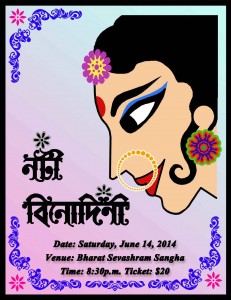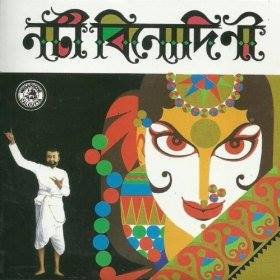I grew up in a small campus town where entertainment options were quite limited. We did have some limited opportunities to watch cinema during the weekends, but that was rare. So we all waited for the Jatra companies to visit our town after the Puja’s with their exciting performances. Months before the show, monochrome or dual tone lithographic posters printed on thin paper covered the walls, lamp posts, even tree trunks all around the town. Publicists of the show organizers announced the details of the upcoming Jatra festival using a battery powered portable PA system mounted on a cycle rickshaw and threw dozens of colorful handbills in the air. Weeks before the festival, walls made of corrugated tin enclosed a large football (soccer) field. The top covered with tarp supported by wooden poles. Inside, in the center of the field, was a square stage built on wooden platforms where the actors performed. The actors entered and exited through a ramp leading from the dressing rooms to the stage. On either side of the stage, at a slightly lower level, sat the musicians who played live music with harmonium, trumpet, cymbals, tabla, dholak, flute etc. The contents of the plays ranged from mythological to historical to social issues. The show used to start sometime around 8 pm, sometimes even later. We all arrived as early as possible to grab the seat closest to the stage to get a good view of the action and the actors. The seat, of course, was on the ground covered with tarpaulin. Those were the cheapest seats. The more expensive upperclass seats were nothing but steel folding chairs placed far from the stage. We, the kids, never liked those seats. We sat there for hours as the ground started to fill up. Vendors skillfully weaved through the seated people with a variety of snack offerings – peanuts, jhaalmuri, chanchur etc. Suddenly, we’d see the musicians entering the stage and taking their seats on the two sides of the stage. The crowd would stir in anticipation. When the first bell rang, the musicians would start to tune their instruments. The loud cacophony that ensued was good enough to prepare the crowd for the next event. In the meantime, one of the Jatra company person would come out to distribute the program or playbill, which was nothing but a yellow piece of paper listing the characters followed by the sequence of scenes, the place where the scene takes place and the characters in those scenes. Since the stage had no sets, scenery or props (except for one chair), the playbill served as a guide to inform when and where a scene was taking place. When the second bell rang, the musicians would begin their opening concert and at the conclusion of which entered the dancers with the opening “item” number.
The Jatra, however, attracted quite a few powerful actors of the time. I have had the good fortune of watching the performances of famous actors like Diju Bhawal, Swapan Kumar, Arun Dasgupta, Bina Dasgupta, Shantigopal and many others. Sometimes, the Jatra producers would try to introduce some special features to attract the people. Like one time, one company announced that they would be presenting, for the first time in the history of Jatra, a completely Technicolor show (sompurno rongin jatra pala). I was very curious to see what they exactly meant by a “Technicolor Jatra Pala,” because I never knew that the Jatra palas we have been watching all these years were in black and white. When the show started, I realized why they made such a claim. The show used a bunch of theatrical flood lights of multiple colors being focussed on the actors on stage in random sequence. The use of colored lights was of course a first, since in most other Jatra shows, they’d use a simple white or amber light good enough to keep the actors visible.
However, the Jatra I remember most, was Natya Company’s classic production – Noti Binodini. Although I saw this play in a proscenium theatre (Open Air Theatre stage in IIT Kharagpur) and not on a typical Jatra stage, still I’d say that it was one of the most memorable Jatra’s of my life. The play, written by Brojendra Kumar Dey, had the right combination of all the melodramatic elements to keep the audience engaged.
The Jatra Noti Binodini is about the sacrifice of a sex worker turned actress Binodini Dashi, a protege of the famous playwright and director Girish Chandra Ghosh. The play depicts the time of the Bengal renaissance when Bengali Theatre, along with other forms of art, literature and culture, was going through a major change. Those days, a woman to act on stage, in front of hundreds of men, was considered to be disgraceful and unacceptable to the society. Hence all female characters on stage used to be performed by men. To make theatre more realistic, Girish Ghosh and some of his contemporaries introduced women actresses on professional stage by hiring and training the sex workers of the city. The story depicts how Binodini was not only marginalized by the society due to her birth, but also how she was exploited by the theatre establishment who wanted to use her to ensure their existence. Finally it was the great reformist Hindu saint, Ramakrishna Paramahansa, who showed her the path to salvation.
After a long time, the New Jersey theater lovers will be able to enjoy Jatra in their own neighborhood. The Jatra pala “Noti Binodini” will be staged at the Bharat Sevashram Sangha premises on Saturday July 14th at 8:30pm. Few years back, the play Noti Bindodini was staged in New Jersey by a visiting theatre company from Kolkata led by the then Indian central minister Mr. Ajit Panja. However, the play was renamed as “Ramakrishna,” most likely to satisfy the minister as he played the title role. The play was staged in a standard proscenium theater and it hardly had the ambiance of Jatra. The Bharat Sevashram Sangha production, I am told, would bring back the feel of the traditional Jatra with a stage open on three sides. Live musicians would play the tunes and songs sung live by the actors themselves. The performers include a bunch of talented local actors who are giving their best to present something new to the community. The show is directed by Aparajita Das and the music is directed by Partha Sarathi Mukherjee.
If you are a Jatra lover like me, then you’d not like to miss this one time opportunity. I am eagerly waiting for the first bell to ring and the concert to begin. Hope to see you there.



A very good insight into this form of performance art….Jatra! A form of entertainment that is a part and parcel of the entire genre, that is Bengali
Thanks to the organizers.
It is a good news to the family members of late Brojendrakumar Dey.
I saw this Nattya Comany’s Jatra Pala Noti Binodini when I was read in class-XI, and I was astonished that the performance is likely to a real story.